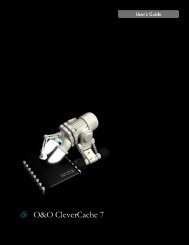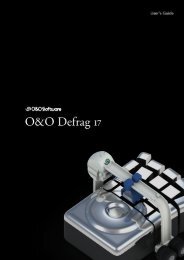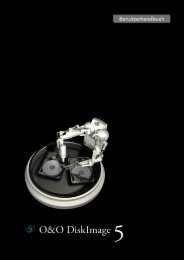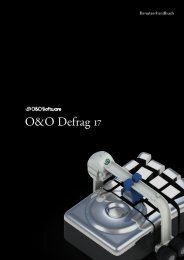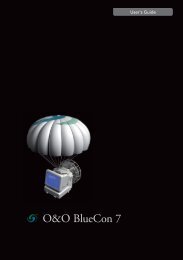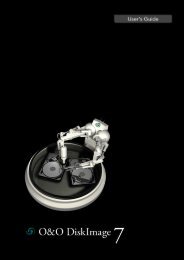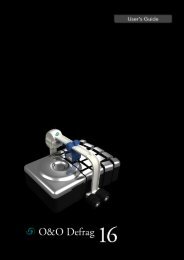Installation and System Requirements - O&O Software
Installation and System Requirements - O&O Software
Installation and System Requirements - O&O Software
You also want an ePaper? Increase the reach of your titles
YUMPU automatically turns print PDFs into web optimized ePapers that Google loves.
shadow copies. Although these files will be displayed as fragmented, they still have only a<br />
minimal influence on the operating speed of your system. You could disable the shadow<br />
copies to achieve improved defragmentation results but you would then wind up losing the<br />
operating system’s built-in backup functionality. That’s why we recommend your leaving the<br />
shadow copies enabled.<br />
Microsoft is already aware of this problem, as this issue also occurs in the Windows native<br />
defragmentation software. More details may be found in this article from Microsoft:<br />
http://support.microsoft.com/default.aspx?kbid=312067<br />
In Windows XP64 <strong>and</strong> Windows 2003 Server, this problem will not occur as long as storage<br />
volumes have been formatted with a cluster size of 16KB or larger. If this cannot be changed<br />
or Windows Vista is in use, this issue can be avoided by first performing a STEALTH defragmentation<br />
followed by a SPACE defragmentation.<br />
STEALTH-Method<br />
The STEALTH method differs from the other methods in that it is much faster <strong>and</strong> uses much<br />
less main memory for the defragmentation.<br />
The STEALTH method has been designed with large file servers in mind. It can, however, be<br />
used to great effect on workstations <strong>and</strong> other computers.<br />
Algorithm<br />
The STEALTH method is based on our unique STEALTH technology <strong>and</strong> allows an unprecedented<br />
level of defragmentation on computers having a large number of files, little free<br />
space or available main memory.<br />
This method defragments all fragmented files <strong>and</strong> tries to consolidate them in order to optimize<br />
available free disk space. Speed <strong>and</strong> resource usage are the main considerations here<br />
<strong>and</strong> the method is therefore not quite as thorough as the SPACE <strong>and</strong> COMPLETE methods.<br />
Recommended Applicaton<br />
The STEALTH method is particularly recommended for the following systems. STEALTH can<br />
also be used for regular defragmentation runs.<br />
• Initial defragmentation of your system<br />
• Computers with few available resources, as the method does not greatly increase the<br />
CPU usage <strong>and</strong> does not require much free hard disk space<br />
• Servers with very large hard disks (e.g. more than 4 terabytes)<br />
• Computers with a very large number of files (more than 3,000,000 files)<br />
User's Guide for O&O Defrag 11<br />
O&O Defrag Methods l 17



